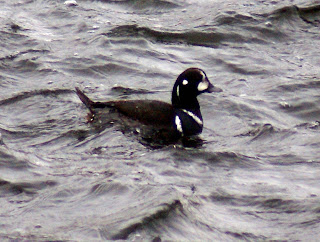View from Bluff Point looking west toward Bluff Point Beach
Saturday promised to be sunny and warm, for a change, so we packed up for an expedition to
Bluff Point State Park in Groton. (Wow, the DEP's website sure could use some new photos). Just 53 miles and a little over an hour from home, this beautiful patch of Connecticut coastal forest, sandy beach and rocky shore, is a real treasure for outdoors-lovers. I can't wait to go back during spring migration! The large parking area is unregulated (no fee, lots of potholes), and even on a January day, picnickers had the grills fired up, dog-walkers were in abundance and we four tromped happily along snowy-muddy trails with our binoculars.
Bluff Point State Park map
Adjacent to the parking lot is the Poquonock River, which this day held abundant gulls and diving ducks.
Ring-billed Gull,
Larus delawarensisHerring Gull,
Larus argentatusGreat Black-backed Gull, Larus marinusRed-breasted Merganser,
Mergus serratorCommon Merganser,
Mergus merganserHooded Merganser,
Lophodytes cucullatusRing-necked Duck, Aythya collarisCommon Goldeneye, Bucephala clangula
Bufflehead, Bucephala albeolaMute Swan,
Cygnus olorCommon Loon,
Gavia immerAlong the far shore, near the Groton-New London airport, a male Northern Harrier flew by, fast and low.
Max relaxing on bench at Bluff Point, Sebastian bouldering
Emerging from the woods at Bluff Point, we admired the view, but added only Common Eider to our bird list. We added zero birds as we walked along the wooded trail to the bluff, not a peep was heard. Perhaps this side of the point was too windy? Continuing along the way to Mumford Point, we alternately walked the rocky shore itself, and the brier-and-beach-rose-lined footpath.
Sebastian and Max exploring a glacial erratic
Detail showing eons of wave action on granite
A trickle of snowmelt on granite ledges
By now, stomachs are beginning to rumble, and once we round the corner of Mumford Point and are out of the wind, we choose a picnic rock. Bread and cheese never tasted so good!
Picnic rock at Mumford Point, Sebastian, Max, Jorge, Sue
Bird activity picked up a little after lunch - there was less wind in the woods, and the tide was falling out in Mumford Cove.
Birds onshore:
White-throated Sparrow
Northern Cardinal
Tree Sparrow
Birds offshore:
Horned Grebe, Podiceps auritus
Black-bellied Plover, Pluvialis squatarola
Dunlin, Calidris alpina
Walking the sandy edges along Mumford Cove, we found many scallop shells, large channeled whelks, a few whelk egg cases, razor clams, quahogs, slipper shells, jingle shells, crabs, lobsters and more.
Swirls of garnet-laden beach sand
Heading back along the woodland trail to return to our car, we picked up a few more birds:
Black-capped Chickadee, Poecile atricapillus
American Robin, Turdus migratorius, more than fifty
White-breasted Nuthatch, Sitta carolinensis
Red-bellied Woodpecker, Melanerpes carolinus
Tufted Titmouse, Baeolophus bicolor
With the sun still up at 4:15, but low, we drove in search of more waterbirds. Along the Mystic River we added:
American Black Duck, Anas rubripes
Mallard, Anas brachyrhynchos
Canada Goose, Branta canadensis
Great Blue Heron, Ardea herodias
Total species count for the day was 32, and we added five new species to our year list, in boldface, bringing the total to 56.
Happy Birding!
















































